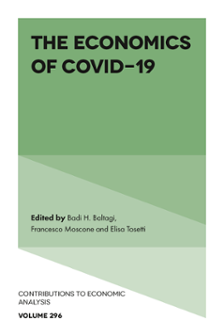
Index
ISBN: 978-1-80071-694-0, eISBN: 978-1-80071-693-3
ISSN: 0573-8555
Publication date: 1 June 2022
Citation
(2022), "Index", Baltagi, B.H., Moscone, F. and Tosetti, E. (Ed.) The Economics of COVID-19 (Contributions to Economic Analysis, Vol. 296), Emerald Publishing Limited, Leeds, pp. 173-178. https://doi.org/10.1108/S0573-855520220000296016
Publisher
:Emerald Publishing Limited
Copyright © 2022 Badi H. Baltagi, Francesco Moscone and Elisa Tosetti. Published under exclusive licence by Emerald Publishing Limited
INDEX
- Prelims
- Understanding Economic Instability during the Pandemic: A Factor Model Approach
- General Equilibrium Analyses of COVID-19 Impacts and Policies: An Historical Perspective
- The Relationship between COVID-19 and the Financial Market
- Exploring the Economic Effects of COVID-19 in the United States through the Seismograph
- COVID-19 and Digital Economy: The Journey towards a Digital Transformation in New Normal: How to Prepare for the Future
- Estimating Uncertainty in Epidemic Models: An Application to COVID-19 Pandemic in Italy
- The Effects of the Pandemic on Mental Health
- Ethnicity and Inequality during the COVID-19 Pandemic in the UK
- The Impact of COVID-19 Pandemic on the Healthcare System in Lombardy
- Index